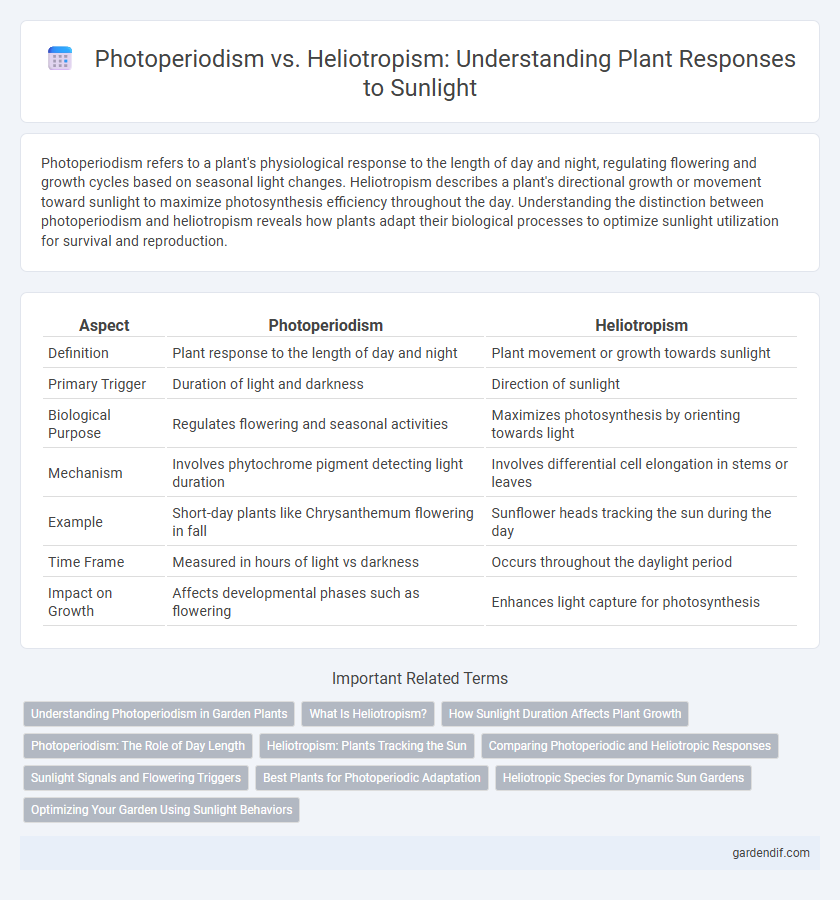
Photoperiodism vs heliotropism Illustration
Photoperiodism refers to a plant's physiological response to the length of day and night, regulating flowering and growth cycles based on seasonal light changes. Heliotropism describes a plant's directional growth or movement toward sunlight to maximize photosynthesis efficiency throughout the day. Understanding the distinction between photoperiodism and heliotropism reveals how plants adapt their biological processes to optimize sunlight utilization for survival and reproduction.
Table of Comparison
| Aspect | Photoperiodism | Heliotropism |
|---|---|---|
| Definition | Plant response to the length of day and night | Plant movement or growth towards sunlight |
| Primary Trigger | Duration of light and darkness | Direction of sunlight |
| Biological Purpose | Regulates flowering and seasonal activities | Maximizes photosynthesis by orienting towards light |
| Mechanism | Involves phytochrome pigment detecting light duration | Involves differential cell elongation in stems or leaves |
| Example | Short-day plants like Chrysanthemum flowering in fall | Sunflower heads tracking the sun during the day |
| Time Frame | Measured in hours of light vs darkness | Occurs throughout the daylight period |
| Impact on Growth | Affects developmental phases such as flowering | Enhances light capture for photosynthesis |
Understanding Photoperiodism in Garden Plants
Photoperiodism in garden plants regulates flowering and growth cycles based on the length of day and night, influencing plant behavior through light-sensitive pigments like phytochromes. Unlike heliotropism, which is the directional movement of plant parts toward sunlight for optimal photosynthesis, photoperiodism triggers developmental changes tied to seasonal light variations. Understanding photoperiodic responses enables gardeners to optimize planting schedules and improve crop yields by aligning growth phases with natural light conditions.
What Is Heliotropism?
Heliotropism refers to the directional growth or movement of plants in response to sunlight, allowing leaves or flowers to maximize light absorption throughout the day. This physiological adaptation enables flowers like sunflowers to track the sun's movement from east to west, optimizing photosynthesis efficiency. Unlike photoperiodism, which regulates developmental processes based on the length of day and night, heliotropism is a dynamic, physical response to the sun's position in real time.
How Sunlight Duration Affects Plant Growth
Photoperiodism regulates plant growth by detecting sunlight duration, triggering flowering and developmental changes based on day length. Heliotropism directs plant parts to track the sun's position, maximizing light absorption for photosynthesis. Variations in sunlight duration influence gene expression related to growth cycles and energy capture efficiency in plants.
Photoperiodism: The Role of Day Length
Photoperiodism regulates plant and animal biological processes based on the length of day and night, influencing flowering, breeding, and dormancy cycles essential for survival. The detection of light duration by phytochrome pigments allows organisms to adapt seasonal behaviors to their environment efficiently. This mechanism differs from heliotropism, which involves the directional growth or movement of plants in response to the sun's position rather than the duration of light exposure.
Heliotropism: Plants Tracking the Sun
Heliotropism refers to the movement of plants as they track the sun's position throughout the day to maximize light absorption for photosynthesis, which enhances growth and energy production. This dynamic adaptation allows plant leaves and flowers to orient toward sunlight, optimizing exposure and improving overall plant health. In contrast to photoperiodism, which senses day length to regulate developmental processes, heliotropism is a direct response to sunlight direction and intensity.
Comparing Photoperiodic and Heliotropic Responses
Photoperiodism regulates plant developmental phases like flowering by measuring day length, while heliotropism involves directional growth or movement of plant parts toward sunlight for optimal light capture. Photoperiodic responses are triggered by specific durations of light and darkness, influencing physiological changes through phytochrome-mediated signal transduction pathways. Heliotropic responses enable dynamic alignment with the sun's position, enhancing photosynthetic efficiency without altering developmental timing.
Sunlight Signals and Flowering Triggers
Photoperiodism relies on sunlight duration as a critical signal to regulate flowering time in plants, with specific wavelengths detected by photoreceptors like phytochromes and cryptochromes. Heliotropism, in contrast, involves the directional growth or movement of plant organs toward sunlight to maximize light absorption, but it does not directly trigger flowering. Understanding the molecular pathways of sunlight perception highlights how photoperiodism precisely controls flowering based on day length, whereas heliotropism enhances photosynthetic efficiency without altering reproductive timing.
Best Plants for Photoperiodic Adaptation
Photoperiodism regulates plant flowering by responding to the length of day and night, making plants like soybeans, chrysanthemums, and poinsettias ideal for controlled flowering cycles. These photoperiodic plants optimize growth phases based on specific light durations, contrasting heliotropism, which involves plant movement toward sunlight. Understanding photoperiodic adaptation helps in selecting crops that maximize yield in varying daylight environments.
Heliotropic Species for Dynamic Sun Gardens
Heliotropic species in dynamic sun gardens actively track the sun's movement throughout the day, maximizing photosynthesis and growth by adjusting their orientation. Unlike photoperiodism, which responds to day length changes to regulate flowering and dormancy, heliotropism enhances light capture efficiency in real-time. Common heliotropic plants like sunflowers and cotton optimize energy absorption through this adaptive solar tracking mechanism.
Optimizing Your Garden Using Sunlight Behaviors
Photoperiodism controls how plants respond to the length of daylight, influencing flowering and growth cycles essential for optimizing garden yields. Heliotropism allows plants to track the sun's movement, maximizing photosynthesis by adjusting leaf orientation to capture optimal sunlight. Understanding these sunlight behaviors enables gardeners to strategically position plants and schedule planting times, enhancing growth and productivity through targeted light exposure.
Photoperiodism vs heliotropism Infographic

 gardendif.com
gardendif.com